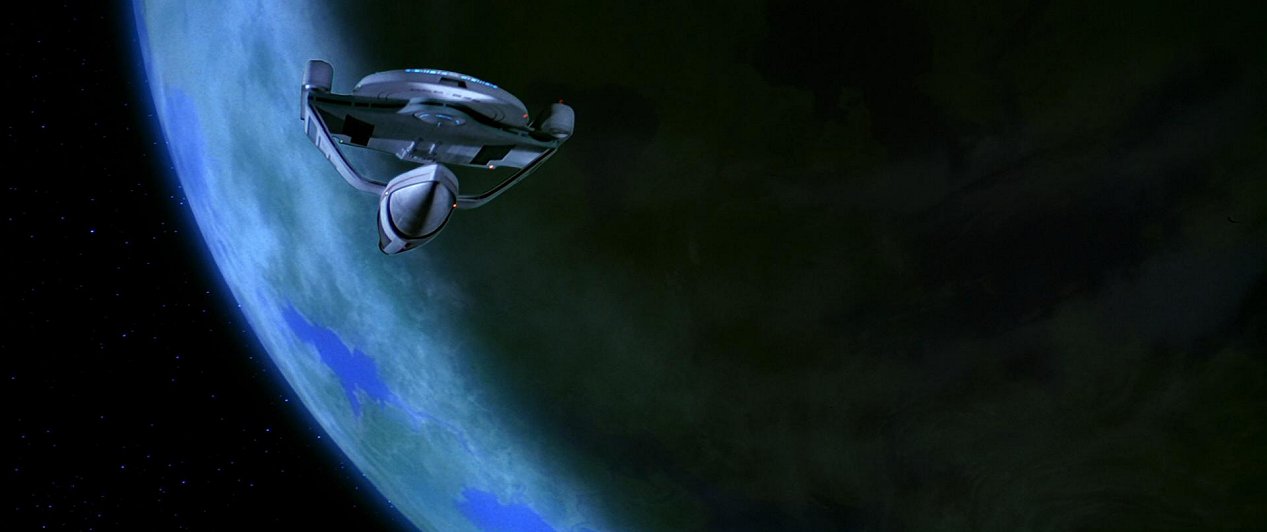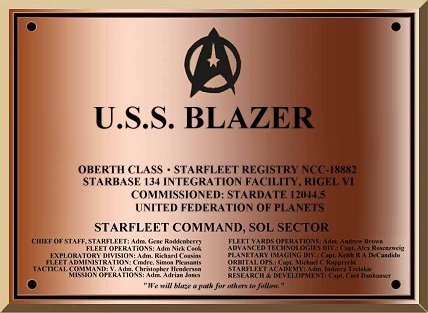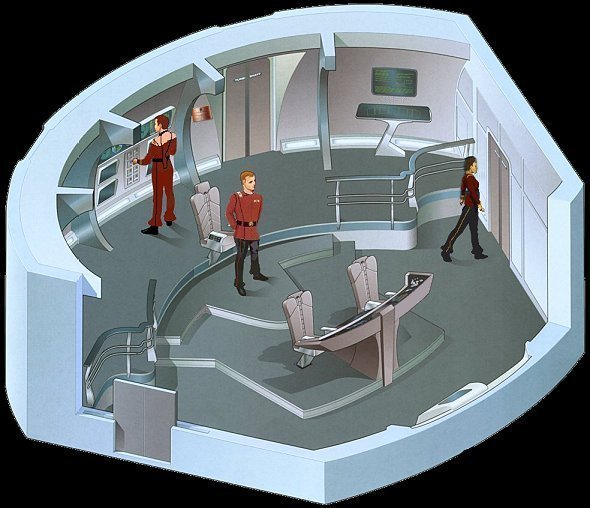

 The Blazer, whose motto is "Blazing a path for others to follow", was launched from Starbase 134 Integration Facility on Stardate 12044.5. NCC 18882 was used for her shakedown on a classified mission in Sector 16334. Freshly-promoted Lieutenant Commander Nathaniel Hawkins was given command for his first taste of the centre seat. Hawkins was assigned to bring the ship up to speed before initiating the classified mission.
The Blazer, whose motto is "Blazing a path for others to follow", was launched from Starbase 134 Integration Facility on Stardate 12044.5. NCC 18882 was used for her shakedown on a classified mission in Sector 16334. Freshly-promoted Lieutenant Commander Nathaniel Hawkins was given command for his first taste of the centre seat. Hawkins was assigned to bring the ship up to speed before initiating the classified mission.
Once in Sector 16334, the Blazer was assigned to test her sensor arrays along the Federation/Klingon and Federation/Romulan borders. Whilst on this mission, the Blazer stumbled upon a Romulan frigate. Most of the incident was classified Top Secret, but scuttlebutt says the frigate appears to have been aware of the presence of the Oberth class scout ship. Other rumours are that the Blazer was spying on the Romulan ship beforehand.
What is known is that, knowing the limitations of the Oberth design and rumoured to be against the wishes of the security chief, Hawkins opted to run and hide. Evasion was the chosen strategy. The game of cat-and-mouse went on for weeks, forcing Hawkins and his team to formulate every defensive tactic they could.
The situation only came to an end when U.S.S. Albion came into the sector to investigate the loss of contact with the Blazer. Albion escorted the Oberth class ship back to starbase 77. The final report on the mission of the Blazer confirmed the ship ready for operations and provided plenty of data for Starfleet to analyse.
Lieutenant Commander Nathaniel Hawkins was transferred away from the Blazer and accepted as the Executive Officer of Captain Raekwon Okigbo of the Miranda class U.S.S. Sheffield. The full details of this mission have yet to be released and Hawkins will not talk about it.
Oberth class vessels continue to serve as the primary scout/surveyor class starship. Production continues with a vessel being launched every few months.
Author's Notes:
This back mission is designed to give Hawkins a past, as well as defining something of the man. Not everyone is a battlefield tactician like Kirk or Picard. Hawkins is a social scientist by training and this experience has, perhaps, flavoured Hawkins preferred battle strategy. It all depends on how accurate this 'scuttlebutt' turns out to be.
Oberth class vessels are science vessels and as such are not designed for combat - just look at the Grissom for the proof. It is interesting to have the cat-and-mouse story overturned with the Federation ship on the run. There will be more on this...
Oberth class arrangement
Deck 1 Bridge, conference room, officer quarters, mess hall, lounge.
Deck 2 Shuttlebay upper deck. Enlisted crew quarters, gym, laundry, cargo bay.
Deck 3 Shuttlebay main deck, cargo bays, escape pod access, cryogenic tankage.
Deck 4 Sickbay, life sciences, transporter, main engineering, computer core, life support, waste recycling.
Deck 5 Deuterium tankage, jeffries tube to secondary hull
Deck 6 Deuterium tankage, jeffries tube to secondary hull, plasma flush vent
Deck 7 Deuterium tankage, jeffries tube to secondary hull, deflector generator, structural integrity.
Deck 8 Science/cartography sensor array, science labs, communication buoy magazine.
Deck 9 Science/cartography sensor array, science sensor processing compartment, buoy/torpedo/probe workshop,
Deck 10 Science/cartography sensor array, aft sensor compartment, life support, batteries.
Deck 11 Science/cartography sensor array, batteries.
The Blazer has two shuttles:
01 Astute
02 Pathfinder
U.S.S. Blazer bridge:
 U.S.S. Blazer has a much simplified Bridge layout, mirroring that of most Oberth class starships in the early 24th Century. With this being a scout/surveyor class science vessel, there is a need for the Bridge to be compact and to-the-point.
U.S.S. Blazer has a much simplified Bridge layout, mirroring that of most Oberth class starships in the early 24th Century. With this being a scout/surveyor class science vessel, there is a need for the Bridge to be compact and to-the-point.
The central positions on the Bridge are dominated by the command chair and helm/navigation console. The station at the rear of the Bridge is a dedicated System Status board - with a Communications station and Science station flanking this. Tactical operations are duplicated on the Helm and Navigation stations due to the dedicated scientific mission of the Oberth class. This is not a tactically able starship - as the demise of U.S.S. Grissom in 2285 demonstrated.
The reduced size of the Bridge reflects both the small size of the Oberth class and the reliance on the laboratories onboard for a lot of the scientific operations. Summaries of the sensor data and studies can instantly be called up onto the science station, allowing the Bridge to instantly know in real time what is being performed by the ship and crew.
This spartan layout of the U.S.S. Blazer bridge has been proposed for other starships of larger size, but most likely, this will only be used for small scout class vessels of the Oberth and Okinawa classes. Author's Note - I still can't believe they suggest the Stargazer Bridge was only this size. They reused the Enterprise-A Bridge from Star Trek IV and I would strongly argue the Bridge was at least that size and layout. We just didn't have this confirmed in the low-lit environment.









 The Blazer, whose motto is "Blazing a path for others to follow", was launched from Starbase 134 Integration Facility on Stardate 12044.5. NCC 18882 was used for her shakedown on a classified mission in Sector 16334. Freshly-promoted Lieutenant Commander Nathaniel Hawkins was given command for his first taste of the centre seat. Hawkins was assigned to bring the ship up to speed before initiating the classified mission.
The Blazer, whose motto is "Blazing a path for others to follow", was launched from Starbase 134 Integration Facility on Stardate 12044.5. NCC 18882 was used for her shakedown on a classified mission in Sector 16334. Freshly-promoted Lieutenant Commander Nathaniel Hawkins was given command for his first taste of the centre seat. Hawkins was assigned to bring the ship up to speed before initiating the classified mission. U.S.S. Blazer has a much simplified Bridge layout, mirroring that of most Oberth class starships in the early 24th Century. With this being a scout/surveyor class science vessel, there is a need for the Bridge to be compact and to-the-point.
U.S.S. Blazer has a much simplified Bridge layout, mirroring that of most Oberth class starships in the early 24th Century. With this being a scout/surveyor class science vessel, there is a need for the Bridge to be compact and to-the-point. 




